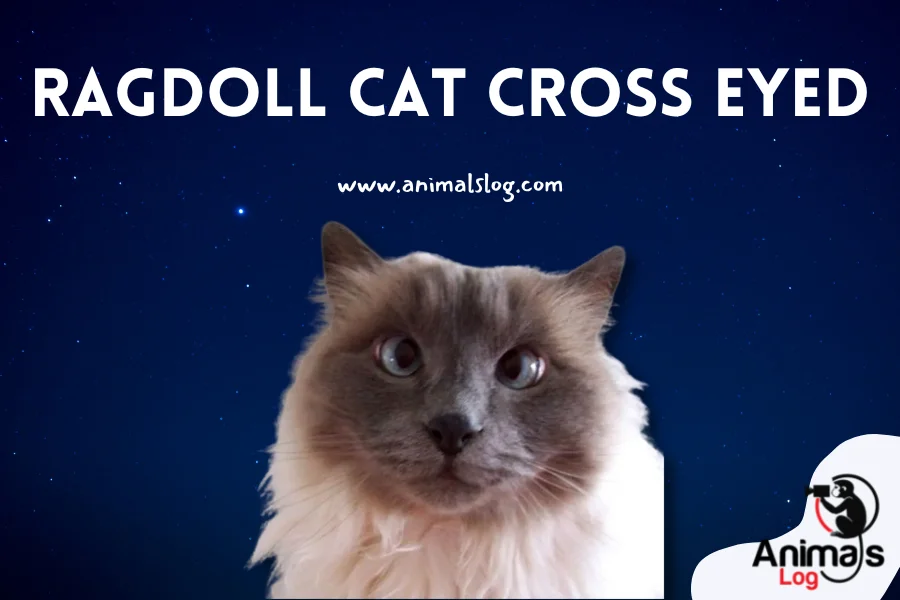Having a ragdoll pet is the best. You get to enjoy the warmth and compassion of a beautiful and adorable pet. Nevertheless, there is always this concern about the health of a ragdoll, which overwhelms all good things because you do not want to lose your cat. One such health condition owners worry about is ragdoll cat cross eyed condition.
Ragdoll cats are recognized for their gorgeous azure eyes, but having these beautiful eyes suffer from ragdoll cat cross eyed can be depressing. Strabismus is the professional term for a syndrome in which the eyes are permanently crossed. Cats born with converging or diverging strabismus usually acclimatize well to their disability and have a decent standard of life.
When ragdoll cat cross eyed is developed as adults, they may have a more significant underpinning cause of worry. Some of these problems are curable, so seek veterinarian help. This condition is not specific to ragdolls or the cat community. It can happen to anyone, even humans. Let us now discuss more ragdoll cat cross eyed conditions.
What Is Ragdoll Cat Cross Eyed?
Strabismus is a frequent eye disorder in ragdolls that affects the eyes to deviate from their natural position, giving them the look of being cross-eyed. It can affect either one or both eyes. Esotropia is a condition in which the eye diverges toward the nose. The cat will be cross-eyed if both eyes are misguided towards the nose. Convergent strabismus is what this is called medically.
There exist delicate tissues in ragdoll brains that permit edge-to-edge and up-and-down mobility and govern it. When one of these tissues is pulled out or overworked, or the connections that regulate these fibers are injured, the eye moves in an unnatural direction causing the ragdoll cat cross eyed.
Strabismus can make it difficult for a ragdoll to concentrate correctly, and it can also make it difficult for the ragdoll to perceive elevation. Strabismus does not lead to vision disability, and the majority of ragdoll cat cross eyed adapt well to their affliction and lead a healthy, joyous life.
Diagnosis Of Ragdoll Cat Cross Eyed

It is a ubiquitous question among cat owners “Do ragdolls have eye problems?”. As a matter of fact, they do, and there is a diagnosis process for it.
The doctor will require all of your cat’s health information to diagnose ragdoll cat cross eyed disease. Subsequently, the patient will have a thorough physiological, neurology, and ophthalmologic evaluation. This can assist in distinguishing between retinal, muscular, nerve, and brain disorders.
A neurological inspection, which includes testing nerve palsy responses, leg balance, and coordination, and assessing your cat’s behavioral condition, may also be performed by your veterinarian. A Schirmer tear test, pupillary light reflex tests, and fluorescein staining of the cornea are all part of an ophthalmologic examination.
Thorough blood analysis and a nutritional evaluation will be performed on the blood. Urinalysis, skull X-rays, CT scans, or MRIs will be required to better look at the optic nerves. Pre-anesthetic tests should be performed on the ragdoll to see if it is fit for performing surgery on it.
Causes Of Ragdoll Cat Cross Eyed
It is now clear that a ragdoll cat cross eyed is either born with it or develops when it matures. There can be many causes behind both.
Born With Ragdoll Cat Cross Eyed:
- Genetic disorder
- Improper muscle growth
- An issue with the inner ear from birth
Developed Ragdoll Cat Cross Eyed:
- Injury to the eye
- Feline leukemia virus
- Developed nerve damage
- Infections and inflammation
- Problems with the brain, like Hydrocephalus
- Cancer or tumor in the eye, brain, or ear
Recommended Reading | Ragdoll Cat Vs Balinese Cat: Which Is Best?
Symptoms Of Ragdoll Cat Cross Eyed
Prevention is always better than cure. Hence, it is always advised to start taking preventive measures to avoid further damage with the first instance of any symptom. One of the most common and visible symptoms is eyes being misdirected. Other symptoms may include:
- Rapid involuntary eye movement.
- Clumsy and lack of coordination in the movement of ragdoll eye.
- Bent head.
- Change in pupil size.
- Difficulty faced by ragdoll to balance, jump or even walk.
- Fatigue and lethargy.
- Lack of appetite and puking.
- Seizures.
- Fever.
- Eyes bulging outwards.
Treatment Of Ragdoll Cat Cross Eyed
While a genetic issue has less chance of being treated, a developed ragdoll cat cross eyed can be treated.
Surgery
If an accident to the eye fibers has resulted in aberrant dimensions or weaknesses, a specialized operation to rectify the extraordinary measures of the afflicted eye muscles may be required. This might aid in the realignment of the eyes. Strike scars can also cause ulcers behind the eye of a ragdoll, which can be treated with an operation.
If a tumor is the origin of ragdoll cat cross eyed, cancer can be treated with an operation and, in some cases, radiotherapy. To prevent the disease from progressing, it may be essential to remove the entire eye. The procedure necessitates general anesthesia. This isn’t widely perceived if the well-being isn’t compromised.
Medications
If a microbial or pathogenic infection is damaging the eye muscles, medications may be required. If your ragdoll has had ragdoll cat cross eyed surgery, make sure to implement all at-home recommendations to ensure speedy healing and resumption to the typical lifestyle of your ragdoll.
Maintain a cover on your ragdoll to avoid damage to the surgery region, provide all drugs as directed, go for routine rechecks and stitch removals as needed, and make your ragdoll stay inside so you can track their health.
Therapy
Physiotherapy for your ragdoll may include daily, friendly eye activities to strengthen eye muscles and coordinate visual stimuli. Physical therapy may be performed to improve the eye muscles after an operation or if the ragdoll has not had a successful surgery. Physical therapy may not be suitable for all ragdolls.
Frequently Asked Questions (FAQs):
Is Ragdoll cat cross eyed common?
It is not common, but it should not be a shock if a ragdoll develops the cross-eyed disease. The disease is also not rare.
Does being cross eyed affect vision?
No, being cross-eyed does not necessarily affect your ragdoll cat’s vision. It depends on the cause of being cross eyed.
How severe is strabismus?
Developed strabismus is more severe than a genetic one. A developed ragdoll cat cross eyed might reflect an infection, injury, or a tumor.
Final Thoughts:
A ragdoll cat cross eyed condition could be problematic for the owner. Nonetheless, we recommend taking the advice of a professional vet as soon as possible. Providing proper treatment and care can cure such conditions and help restore your ragdoll’s life.







